My Materials
Study Guide -- Scene-by-scene questions. To be done as students read the play. Kinda proud of these.
“Helen” Passage for annotation, explication, etc.
Faustus Overall -- Discussion Questions that focus on the play as a whole.
Citing Evidence -- Students are required to cite evidence (specific details and textual
evidence only) for five statements/extracts about the play. A sample Evidence Extract is also available for the statement, “Faustus is foolish.”
The Over-Reacher -- Focuses on Marlowe’s use of hyperbole with a slight deconstructive bent. Harry Levin’s excellent The Over-Reacher, a critical biography of Marlowe, is worth hunting down.
Creative Writing -- a baker’s dozen.
Connections -- theme statements to provoke discussion.
Critical Analysis -- asks students to apply a definition of “tragedy” to Doctor Faustus.
Possible Theses -- best for a longer essay, written and revised mostly outside class.
Faustus Test -- Objective and short answer questions. Also a shorter short answer exam.
 Ancillary Poems for Enrichment -- Ancillary Poems for Enrichment --
Thug Notes for Faustus -- as always, forewarn ing, may not be appropriate for class.
 Teacher Resources Teacher Resources
Audio of the Play -- Librivox offers a wonderful free version, act by act (1:43 total time). Also inlcudes links to various text versions.
Text of the Play -- Assignments here are based on the Signet edition.
Teacher Guides
Performance Study Guides -- Theatre companies that
have actually performed the play offer insight, especially if
you are interested in approaching the play as a stage production.
Laying the Foundation Vocabulary -- 292 words and definitions.
Study Questions -- In order, mostly at a recall and comprehension level. Good for reading checks as well.
Crossref.it.info -- This
British site includes extensive background and three video scenes for
analysis (with worksheets, including text, below). Introductory worksheets
on the Role of Comedy, Elements of the Gothic, the Seven Deadly Sins,
and Marlowe’s Style. These include excellent challenging group
activities.
- Investigate worksheet covers the whole play
- “Intertextuality and the Context of Reception”
 Musical Resources Musical Resources
 Randy Newman’s Faust: With Newman as the Devil and James Taylor as God, this modern rock opera really rocks. In his modern adaptation of Goethe’s Faust, they fight for the
soul of Notre Dame student Henry Faust, played by The Eagle’s Don
Henley. Elton John, Linda Ronstadt, and Bonnie Raitt guest. The cynical
narrative is long and winding, but the songs stand on their own,
especially “Bleeding All over the Place,” “Can’t Keep a Good Man Down,”
“Life Has Been Good to Me” and “Feels Like Home.” YouTube highlights. Randy Newman’s Faust: With Newman as the Devil and James Taylor as God, this modern rock opera really rocks. In his modern adaptation of Goethe’s Faust, they fight for the
soul of Notre Dame student Henry Faust, played by The Eagle’s Don
Henley. Elton John, Linda Ronstadt, and Bonnie Raitt guest. The cynical
narrative is long and winding, but the songs stand on their own,
especially “Bleeding All over the Place,” “Can’t Keep a Good Man Down,”
“Life Has Been Good to Me” and “Feels Like Home.” YouTube highlights.
Other Modern Musical Interpretations:
Classical Musical Interpretations:
Beethoven, Berlioz, Liszt, Mahler, Mendelssohn, Mussorgsky, Schubert,
Schumann, and Wagner -- to name a few bewitched by the Legend.
 Opera: The most famous operatic adaptations, Berlioz and Gounod -- are based on Goethe.
Opera: The most famous operatic adaptations, Berlioz and Gounod -- are based on Goethe.
Hector Berlioz’s La Damnation de Faust. Full opera on YouTube.
The Virginia Opera offers a very accessible guide to Charles Gounod’s Faust.
And, of course, there is Gertrude Stein’s “Doctor Faustus Lights the Lights,” her libretto for a modernist opera, drawing upon both Marlowe and Goethe. YouTube has several clips, but the Temptation Scene from a French production and Concordia University’s Trailer are intriguing.
PowerPoints
None
of these are mine, but each could be useful. Three offer an overview of
Marlowe’s life and give a background to the play -- Marlowe 1, Marlowe 2, Marlowe 3. Others present the Faust Legend and analyze the character of Mephistopheles.
Stage Performance
A full stage performance by Bethany Lutheran College drags a bit, but may be interesting for undivudual scenes and staging. |
|
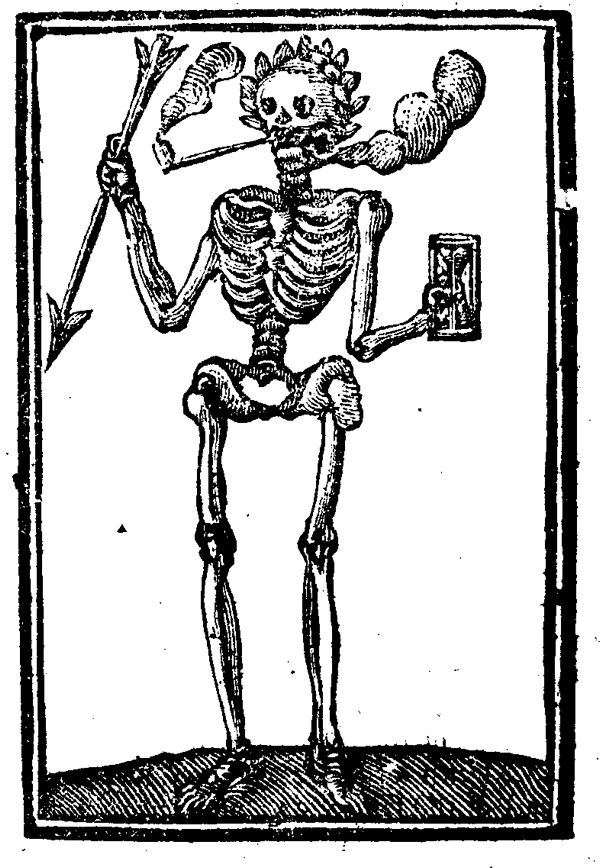 Student Resources Student Resources
Dramatis Personae -- Who’s Who in the Play
Seven Deadly Sins
Marlowe Biography
Structure Overview
Barrons Book Notes (in Word .doc form) -- excellent character and plot analysis
Course Hero Study Guide and Infographic
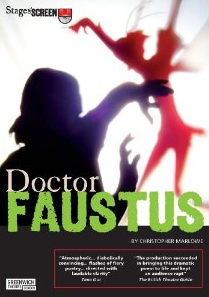 Video Versions Video Versions
Stage on Screen
-- This British company provides stage productions on DVD, with an
extensive accompanying guide of more than 60 pages. Filmed 2009
performance. Website includes four video exerpts. £19.99 or $31.00. Love mine!
The short cartoon, Danse Macabre,
music by Camille Saint-Saëns, available originally from PBS, sets the
mood of the play, though it is not part of the play itself.

Doctor Faustus
-- The infamous Richard Burton / Elizabeth Taylor version (1968)
actually has
redeeming qualitiues, perhaps because Nevill Coghill helped adapt the
play for the screen. The last scene in which Hell opens underneath
Faustus’s study makes up for the endless and inappropriate multiple
scenes with Taylor.
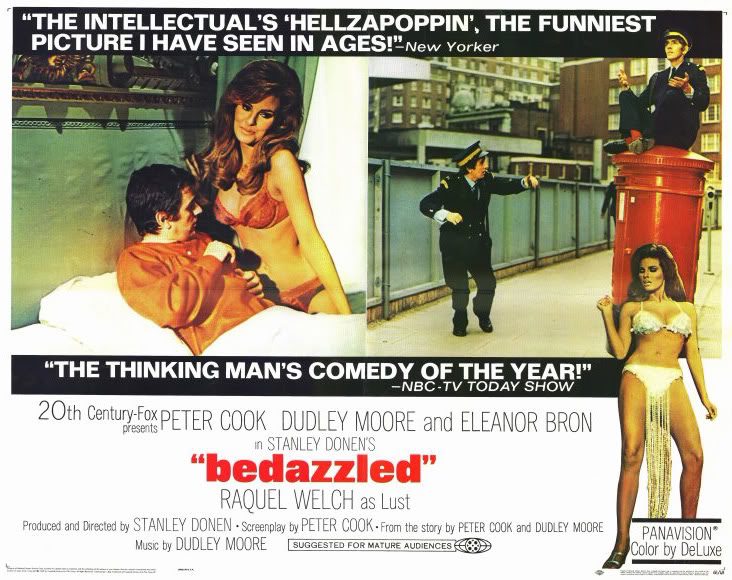
Bedazzled
-- This comic adaptation parallels the Faustus story. Made in 1967 and
remade in 2000, the most useful and entertaining aspect of each tale is
the Seven Deadly Sins psychomachia.
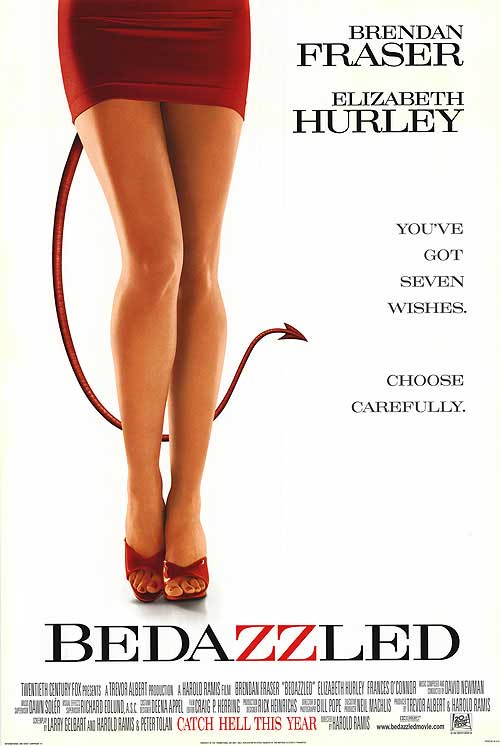
The movie posters may be the best part of the remake.
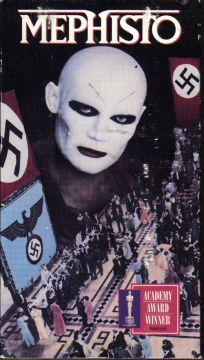 István Szabó’s Mephisto (1981) is a film adaptation of Klaus Mann’s
novel of the same name, twists the tale in even darker ways. Set in
pre-WWII Germany just as the Nazis take power, this is a powerful
metaplay. Bitterly ironic, the actor protagonist dreams of
playing Mephisto, achieving this dream by selling his soul, only to realise too late that in reality he has become Faustus. István Szabó’s Mephisto (1981) is a film adaptation of Klaus Mann’s
novel of the same name, twists the tale in even darker ways. Set in
pre-WWII Germany just as the Nazis take power, this is a powerful
metaplay. Bitterly ironic, the actor protagonist dreams of
playing Mephisto, achieving this dream by selling his soul, only to realise too late that in reality he has become Faustus.
Excellent Roger Ebert review.
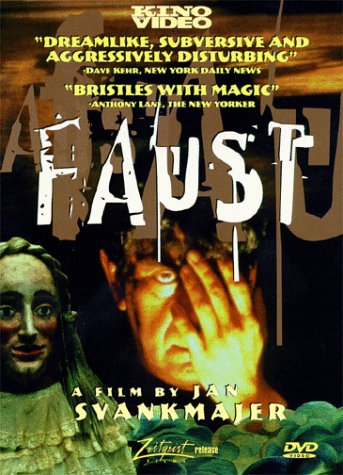 Although Jan Švankmajer’s Faust
does not accurately portray the plot, it imaginatively utilizes the
legend, borrowing and blending elements from the story as told by
Goethe and Christopher Marlowe with traditional folk renditions.
Distinctly Modernist, Absurdist, and Kafkaesque feel, the tone is dark
but humorous. Although Jan Švankmajer’s Faust
does not accurately portray the plot, it imaginatively utilizes the
legend, borrowing and blending elements from the story as told by
Goethe and Christopher Marlowe with traditional folk renditions.
Distinctly Modernist, Absurdist, and Kafkaesque feel, the tone is dark
but humorous.
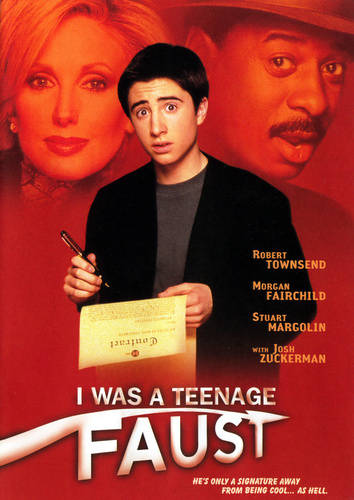
OK, time to spare -- try I Was a Teenage Faust (2002), made for Canadian TV by ShowTime, with Robert Townshend and Morgan Fairchild. Goethe’s Faust.
Visual Interpretations
The Faustus Legend has inspired many artists, though not all are specific to Marlowe’s play. Many
of the visual representations of the Faust story make excellent introductions to the play. From the
original “cover” illustration to the latest theatre production poster,
the tone is set for a play that remains relevant.
Each individual illustration can be used as a simple writing prompt, focusing on visual literacy --
“What is the effect of the illustration and how is that effect is produced?”
Or use the OPTIC guidelines for writing about visual texts.
Visual Versions: Enjoy more than sixty illustrations of the Faust story -- book covers, movie posters, theatrical playbills, even comic books.
 Artistic Interpretations: These ten pieces of art span 400 years of the legend -- etchings, drawings, paintings, and sculptures. Artistic Interpretations: These ten pieces of art span 400 years of the legend -- etchings, drawings, paintings, and sculptures.
 Movie Clips
also present a unique opportunity for visual literacy. Each could be
used to introduce the play or evaluated as a fair or unfair
representation of the play after reading. Or, of course, use the OPTIC guidelines or prompt above. Movie Clips
also present a unique opportunity for visual literacy. Each could be
used to introduce the play or evaluated as a fair or unfair
representation of the play after reading. Or, of course, use the OPTIC guidelines or prompt above.
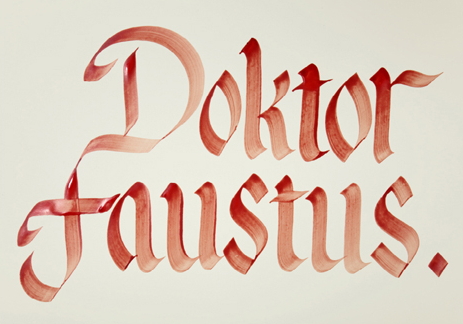
|
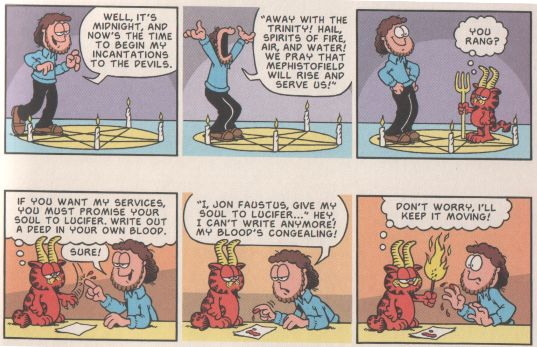


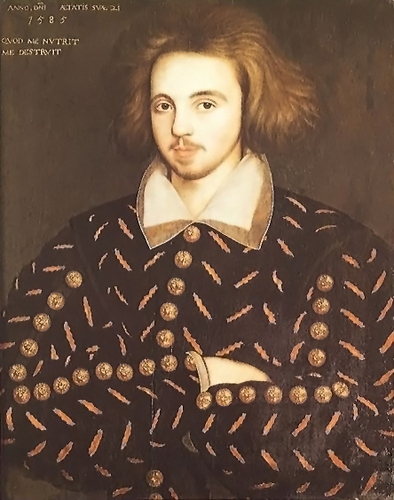


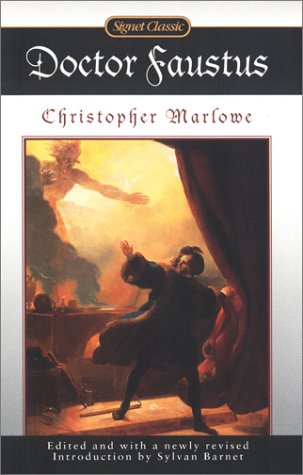
 Randy Newman’s Faust: With Newman as the Devil and James Taylor as God, this modern rock opera really rocks. In his modern adaptation of Goethe’s Faust, they fight for the
soul of Notre Dame student Henry Faust, played by The Eagle’s Don
Henley. Elton John, Linda Ronstadt, and Bonnie Raitt guest. The cynical
narrative is long and winding, but the songs stand on their own,
especially “Bleeding All over the Place,” “Can’t Keep a Good Man Down,”
“Life Has Been Good to Me” and “Feels Like Home.”
Randy Newman’s Faust: With Newman as the Devil and James Taylor as God, this modern rock opera really rocks. In his modern adaptation of Goethe’s Faust, they fight for the
soul of Notre Dame student Henry Faust, played by The Eagle’s Don
Henley. Elton John, Linda Ronstadt, and Bonnie Raitt guest. The cynical
narrative is long and winding, but the songs stand on their own,
especially “Bleeding All over the Place,” “Can’t Keep a Good Man Down,”
“Life Has Been Good to Me” and “Feels Like Home.” 





 István Szabó’s Mephisto (1981) is a film adaptation of Klaus Mann’s
novel of the same name, twists the tale in even darker ways. Set in
pre-WWII Germany just as the Nazis take power, this is a powerful
metaplay. Bitterly ironic, the actor protagonist dreams of
playing Mephisto, achieving this dream by selling his soul, only to realise too late that in reality he has become Faustus.
István Szabó’s Mephisto (1981) is a film adaptation of Klaus Mann’s
novel of the same name, twists the tale in even darker ways. Set in
pre-WWII Germany just as the Nazis take power, this is a powerful
metaplay. Bitterly ironic, the actor protagonist dreams of
playing Mephisto, achieving this dream by selling his soul, only to realise too late that in reality he has become Faustus. Although
Although 
